Exploring the Craft and Culture of Workshop Skateboards
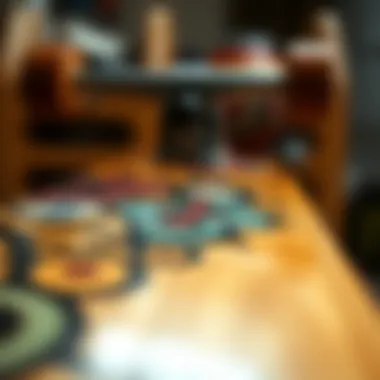
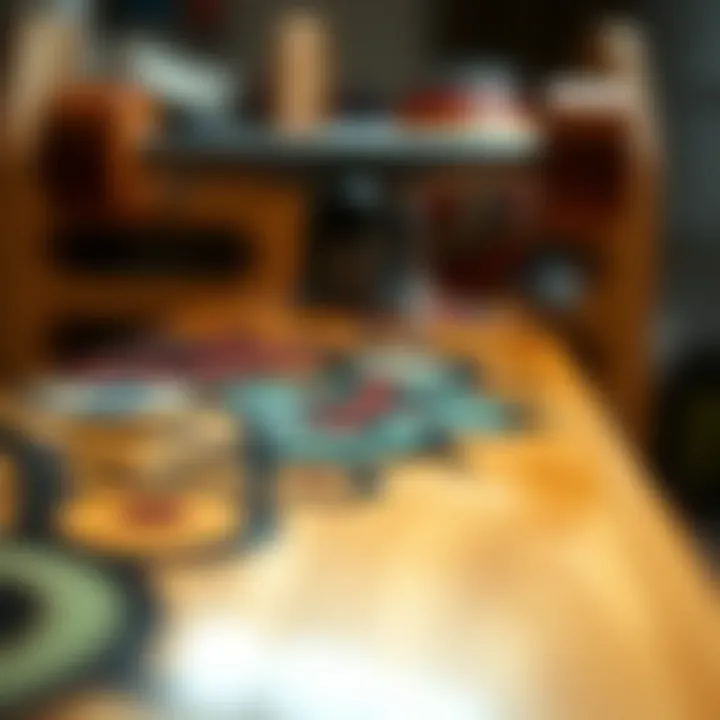
Intro
Skateboarding isn't just a mere hobby; it's a culture, a lifestyle, and an art form. At the heart of this community lies the world of workshop skateboards, which combines creativity with craftsmanship. These unique boards are not merely tools for riding; they encapsulate stories, aspirations, and the collective identity of skaters worldwide.
Creating a skateboard in a workshop goes beyond manufacturing; it’s an intricate dance of design and engineering. Each board tells its own tale, reflecting the hands that crafted it and the passion embedded in its structure. As we dive into the remarkable world of workshop skateboards, we’ll explore how design influences performance, shedding light on the technical specifications that enthusiasts and professionals alike admire.
Moreover, the cultural implications of workshop skateboards cannot be ignored. In skate parks and streets, these boards build bridges between individuals from vastly different backgrounds. They foster a community where creativity meets collaboration, and where competition adds to the fabric of skate culture.
With this piece, we aim to offer a comprehensive understanding of how workshop skateboards play a pivotal role in the skateboarding ecosystem. Whether you’re a seasoned skater or just starting, you’ll find something valuable within.
Skateboarding News Updates
Skate Competitions Recap
Keeping up with competitions is vital for any skater or enthusiast. Not only do these events showcase the latest tricks and talents, but they also highlight emerging trends in the community. For example, the recent X Games brought forth a slew of skateboarders who are redefining the limits of what’s possible on a board.
“Skateboarding is not just about landing a trick; it’s about self-expression and pushing boundaries.”
New Product Launches
In today’s market, new skateboard products roll out with impressive frequency. Local workshops often unveil bespoke boards that cater to specific styles, demonstrating the growing trend toward customization. Notable brands like Element and Santa Cruz are known for their innovation, continuously refreshing their lines to meet the demands of skaters who seek personal expressions through their gear.
Skateboarding Events Coverage
Skateboarding events serve as essential gatherings for enthusiasts of all levels. From local get-togethers to global competitions, each event is a chance for skaters to connect and showcase their skills. With events popping up in urban centers worldwide, the culture continues to expand and evolve rapidly.
Trick Tutorials and Guides
Beginner Tricks Breakdown
For those stepping onto a board for the first time, starting with foundational tricks is crucial. Knowledge of how to perform an Ollie or a Kickflip sets the stage for longer-term success. It's all about mastering the basics before delving into more advanced maneuvers.
Advanced Trick Tips
Once the basics are under control, skaters might delve into more ambitious tricks like the Varial Flip or the 360 Degree Flip. These require not only skill but also a deep understanding of one’s own balance and speed. Understanding how different setups—like the distance between trucks—impact performance can be a game-changer.
Freestyle and Street Skate Techniques
Moreover, freestyle skateboarding emphasizes creativity. Tricks like the Noseblunt Slide or even simplistic ground slides offer significant room for expression. Street skaters often incorporate environmental elements into their routines, which calls for adaptability and innovation in technique.
Skateboarding Culture and Lifestyle
Skateboarding Influencer Spotlights
Among the vibrant tapestry of skate culture, influencers play a pivotal role in shaping trends and perspectives. They guide newcomers while keeping seasoned skaters in the loop about evolving styles, equipment, and skate philosophy. Social media platforms serve as the launchpad for these personalities to share their unique approaches to the sport.
Skatepark Reviews
Local skateparks often become a second home for skaters. Exploring these spaces is almost sacred—their layout, ramps, and overall vibe contribute to the collective experience. Detailed reviews help future skaters choose where to hone their skills and make connections within the community.
Skateboarding Fashion Trends
Skate fashion has become an artistic expression in its own right. Baggy pants, graphic tees, and colorful shoes are more than just a style; they reflect individual character and the cultural backdrop of skateboarding. Keeping an eye on evolving fashion trends can give insight into the broader culture in which skateboarding exists.
Gear Reviews and Recommendations
Skateboard Deck Reviews
Diving into deck types can offer skaters a myriad of options that fit their riding style. Brands like Plan B or Almost produce decks tailored to various preferences, from street styles to vert. Reviews can guide skaters on which decks hold up best against impacts, offering insights from seasoned riders.
Truck and Wheel Comparisons
Trucks and wheels perform crucial roles in the overall feel of a skateboard. With brands like Thunder and Bones leading the industry, it's important to analyze how different setups affect performance. Lightweight trucks may offer more agility, while larger wheels provide a smoother ride over rough terrain.
Protective Gear Suggestions
Any seasoned skater will tell you that protective gear is indispensable. Helmets, knee pads, and elbow pads from brands like Pro-Tec not only keep you safe but also enhance your confidence to try out new skills without fearing injury. When it comes to skateboarding, safety isn't just smart—it's crucial.
Healthy Lifestyle for Skaters
Injury Prevention Exercises
Injuries are part of skating, but there are ways to mitigate risks. Simple exercises can strengthen the body and improve flexibility, making a world of difference. Skaters should focus on ankle and knee stability to help prevent common injuries.
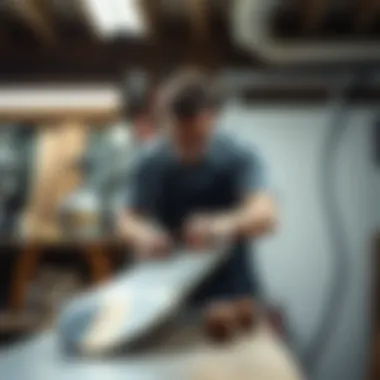
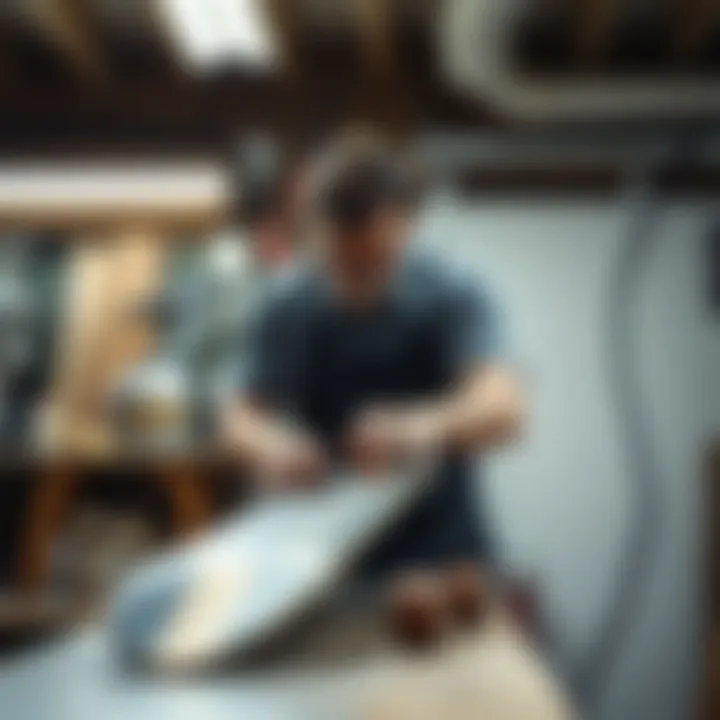
Skateboard Fitness and Strength Training
Building strength is paramount. So, routines that enhance core strength, leg power and balance play a significant role in performing skateboarding tricks effectively. Incorporating forms of cross-training can enhance endurance and overall athleticism.
Nutrition Tips for Skaters
Nutrition often gets overlooked in the skate community. However, a proper diet fuels performance and recovery. Foods rich in antioxidants, protein, and carbohydrates provide energy for those long sessions at the park, while hydration remains key for both focus and performance.
Preface to Workshop Skateboards
The realm of skateboarding transcends mere sport; it is a lifestyle, a culture, and a form of artistic expression. In this context, workshop skateboards embody not only a mode of transportation but also a canvas for creativity and craftsmanship. This section intends to lay the foundation for understanding the significance of workshop skateboards within the broader spectrum of skateboarding culture.
Definition and Context
Workshop skateboards refer to those boards crafted in specialized settings, often emphasizing handcrafted techniques and personalized designs. These aren't mass-produced products cranked out on assembly lines. Instead, they reflect the unique vision and style of the builder, whether that be an individual artisan or a dedicated shop. The choice of materials, design nuances, and construction methods all speak volumes about the artisanal quality embedded in each board.
In a world where mass consumption often overshadows individual artistry, workshop skateboards offer a refreshing alternative. They represent a commitment to quality and sustainability, as most builders take pride in sourcing local materials and minimizing waste. Skateboarders who choose these boards often find themselves gravitating towards a community that values craftsmanship and the stories behind each piece.
Historical Overview
The evolution of workshop skateboards can be traced back to the roots of skateboarding itself, originating in California during the late 1940s and early 1950s. Initially, surfers looking to replicate their ocean thrills on land fashioned their own boards from whatever materials they could find. As the sport expanded in popularity, the need for more specialized boards became apparent.
In the 1970s, a significant shift happened when companies began producing skateboards professionally, yet it was the emergence of boutique shops in the 1980s that reintroduced the concept of handmade boards. These workshops flourished, driven by innovative designs and the desire for individuality among skaters. Shops like Santa Cruz Skateboards and Powell Peralta played pivotal roles in establishing a culture that appreciated not only performance but also craftsmanship.
Fast forward to the present day, and the landscape has shifted once again. With the rise of social media and online platforms, skateboarders can now access an array of workshop producers worldwide. This global community fosters connections that cultivate a rich tapestry of styles and designs, breathing new life into traditional techniques while encouraging fresh ideas.
Ultimately, workshop skateboards are more than just tools for riding; they are symbols of culture, identity, and artistry that invite enthusiasts to become part of a vibrant community. The path forward in this sphere is paved with possibilities, driven by the ingenuity of craftsmen and the passion of skaters.
The Craftsmanship Behind Skateboards
The craftsmanship behind skateboards is not merely a technical endeavor; it's an intricate dance of art and science that shapes the very essence of skateboarding culture. A well-crafted skateboard serves as an extension of the rider, reflecting personal style while being engineered for performance and durability. Understanding the nuances of this craftsmanship is essential both for enthusiasts seeking high-quality boards and for anyone curious about the deeper layers of skating culture.
Materials Used
Wood Selection
When we talk about wood selection, we’re diving into a critical aspect of skateboard construction. The choice of wood can really make or break the board’s performance. Most skateboards are made from a specific type of maple, particularly North American hard maple. This wood is celebrated for its high tensile strength and flexibility which contributes to a smoother ride and enhanced durability.
One of the standout characteristics of this wood is its lamination strength. This means that the boards can endure the stress of tricks without splintering or breaking too easily. However, one downside to hard maple is that it can be slightly heavier than other materials, which might not suit all skateboarders' preferences.
Grip Tape Diversity
Grip tape plays a surprisingly pivotal role in the overall experience of skating. This non-slip material, typically made from a sandpaper-like texture, enhances grip on the deck, allowing riders to execute tricks more confidently. The diversity in grip tape comes from different textures, colors, and even patterns, where people can customize their boards to suit their tastes.
Key characteristic here is its customizability, which adds both style and functionality. You can find grip tapes that feature vibrant designs or even custom art, opening the door for personal expression. However, thicker grip tapes can sometimes compromise the board's feel underfoot, making the balance between grip and finesse a tricky one to navigate.
Hardware Components
The hardware components of a skateboard, including trucks, wheels, and bolts, are the unsung heroes of the setup. The trucks are what connects the wheels to the deck, affecting how smoothly the board turns and how well it holds up during tricks. High-quality trucks allow for better stability and control, which is essential for advanced maneuvers.
Another noteworthy element is wheels; they come in various durometers and diameters—each suited for different types of skating. Softer wheels (lower durometer) provide a smoother ride but can slow you down, while harder wheels (higher durometer) offer speed and slide potential—but at the cost of comfort over rough terrains. Understanding the nuances here can significantly enhance the rider's performance.
Construction Techniques
Layering Process
The layering process of a skateboard is akin to assembling a delicate puzzle. Typically, multiple layers of wood—usually seven—are glued together to create a sandwich of durability and flexibility. This layered construction allows the board to flex just enough to absorb impacts while providing a resilient surface for tricks.
The benefit of this technique is that it makes the skateboard remarkably resilient. However, the glue used must be of high quality, or else the layers might delaminate, leading to a board that is prone to breaking. It’s a careful balance of craftsmanship and material science.
Pressing Methods
When we look at pressing methods, we’re talking about how these layers are transformed into the actual skateboard shape. There are various methods for pressing, from traditional hand-pressed techniques to more modern hydraulic presses. The pressing method can affect the board's concave and shape—critical elements that influence how a skateboard rides.
The meticulous nature of pressing leads to consistency in quality, which is vital in manufacturing. That said, hand-pressed boards might allow for greater customization, whereas hydraulic presses can produce boards at a larger scale. Each method carries its own set of pros and cons.
Finishing Touches
Finishing touches may seem trivial, but they actually play a big role. This includes sanding, painting, and putting on the grip tape. The sanding process ensures that the edges are smooth, reducing chances of injury for the rider. A well-finished board not only looks more appealing but also enhances grip and performance.
Custom finishes can give a board a unique flair, while some may prefer a more industrial look. However, over-finishing can sometimes add unnecessary weight or alter the board’s flexibility, making craftsmanship crucial in this phase too.
Craftsmanship in skateboarding isn’t just about what feels good but also what resonates with the rider's identity and their experience on the board.
Types of Workshop Skateboards
The realm of workshop skateboards is as diverse as those who ride them, reflecting personal styles and preferences. Recognizing the nuance within this variety is pivotal, as it provides insights into not just choices but also the philosophies that underlie the skateboard culture. The different types encapsulated here—custom designs and product lines from renowned shops—demonstrate how artistry and community intersect, thus enriching the skateboarding experience.
Custom Designs
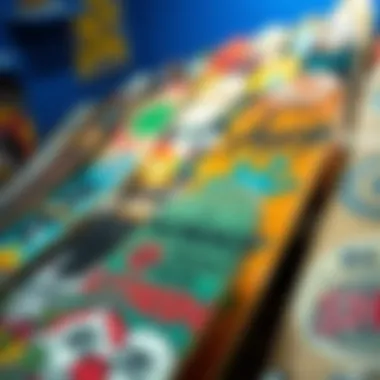

Custom skateboard designs offer a unique opportunity for riders to express individuality. Beyond mere aesthetics, these boards often carry a personal narrative. When a skateboarder decides to commission or create a custom board, they are essentially participating in a dialogue with the craftsman. Each stroke of paint or choice of wood speaks to their identity, aspirations, or even their local influences.
This personal connection isn't just a whim; it's a testament to craftsmanship. Skateboarders who seek custom designs tend to value not just functionality but the emotional engagement with their boards. Individual sketches or unique color palettes serve to tell a story, often linking to cultural themes or personal milestones.
Additionally, customizing a skateboard allows for practical adjustments that are tailored to a rider's specific style. For instance, a skater who favors street tricks might prefer a wider tail or a certain grip tape texture that can enhance performance. The beauty in customization lies in its limitless potential.
Product Lines from Renowned Shops
Turning to esteemed skateboard workshops reveals product lines that also showcase ingenuity and tradition. When shops like Element Skateboards or Almost Skateboards create their product ranges, they combine years of experience with fresh designs to cater to a broad audience. Each board design from these brands intertwines the heritage of skate culture with contemporary trends.
The significance here stretches beyond mere consumption; it speaks to a sense of belonging within the community. Owning a skateboard from a celebrated workshop often carries cachet among peers, functioning as a status symbol while endorsing a shared culture. It's not simply about riding a board; it’s about riding a piece of history and art.
Additionally, these established brands often prioritize quality materials and construction methods to ensure durability and performance. Their boards stand the test of time, reflecting a commitment to sustainability and responsive design.
"Skateboarding is a lifestyle, and the boards we choose often represent who we are within the culture."
Through this lens, workshop skateboards not only function as tools for transport but also as canvases that capture distinct stories and collective history.
For further reading on skateboard culture and designs, you might find these links insightful:
- Wikipedia Skateboarding
- Britannica Skateboarding
- Reddit Skateboarding Community
- Skateboarding in Culture
- Facebook Skateboarding Page
The Culture of Skateboarding
Skateboarding isn’t just a sport; it is a whole culture that encapsulates the creativity, spirit, and camaraderie of those who ride. Through the lens of workshop skateboards, we can explore how craftsmanship intersects with the vibrant life of skateboarders, their communities, and the shared experiences that bind them. This culture serves as the backbone of skateboarding, highlighting not only the artistry involved in board creation but also the social interactions and lifestyle choices that accompany it. Here, we analyze the facets of community, influential figures, and the overall environment in which skateboarding thrives.
Community Dynamics
Skate Parks as Gathering Places
Skate parks act as more than just places to shred; they are essential hubs for the skateboarding community. They are where stories are shared, skills are honed, and friendships are forged. The unique feature of these parks is their design, often tailored to cater to skaters of all levels and styles. For instance, the variety of ramps, rails, and bowls serve challenges and enjoyment whether you’re a newcomer or a seasoned rider.
The atmosphere in a skate park can be electric, marked by the noise of wheels on concrete and the laughter of skaters pushing their limits. These parks are often free to access, making them a popular choice for anyone looking to engage with others without the burden of high fees.
However, skate parks also reflect the challenges of community dynamics. When poorly maintained or managed, they can attract negativity and conflict. A well-maintained park promotes safety and friendliness, while a neglected one can deter participation and limit the community's growth.
Events and Competitions
Events and competitions serve as pivotal moments in the skateboard calendar, showcasing talent and bringing the community together. These gatherings are often colorful displays of skill, creativity, and local pride. They highlight the competitive side of skateboarding, pushing riders to perform at their best while also celebrating the uniqueness of each skater’s individual style.
Notable competitions like the X Games or local contests at community skate parks can help elevate lesser-known skaters into the limelight. They can build a sense of belonging, as participants cheer for friends and peers. This supportive environment fosters a greater connection to the skateboarding culture.
The downside, however, is that competition can sometimes overshadow the pure joy of riding. Excessive emphasis on winning can lead to pressure rather than celebration. Striking the balance between competition and community spirit is vital in keeping the culture strong and inclusive.
Online Forums and Social Media
In the digital age, online forums and social media platforms play a crucial role in shaping the identity of the skateboarding community. They provide spaces for skaters to share techniques, showcase their custom boards, and connect with others globally. Websites like Reddit serve as discussion hubs where skaters exchange ideas and experiences, while Instagram offers a visual feast of skills and lifestyles that define skateboarding today.
The knowledge shared within these forums can be invaluable. Skaters can learn about new techniques, discover local events, or even get tips for board maintenance. The immediacy of social media offers an unprecedented way of keeping the community informed and engaged.
However, while online connections are essential, they can dilute in-person interactions. Over-reliance on digital platforms risks losing the quintessential experience of a skate park, where face-to-face exchanges foster stronger bonds. Balancing online engagement with real-world interactions is crucial for the well-being of the community.
Influential Figures in Skateboarding
The culture of skateboarding is immensely influenced by figures who not only excel in technical skills but also embody the spirit of the community. Icons like Tony Hawk and Bob Burnquist have shaped not just skateboarding trick levels but the attitudes and motivation of upcoming generations.
Some figures might be known for pushing boundaries in tricks, while others might emphasize sustainability in skateboarding or community service. They set a tone that can inspire and energize both the culture and the craft, impacting countless lives through their advocacy and personal narratives.
Moreover, these figures often establish foundations or mentorship programs aimed at fostering new talents, ensuring the culture continues to thrive. Their involvement highlights that skateboarding is not solely an individual pursuit but a communal journey that can leave lasting impacts in and out of skate parks.
Workshop Skateboards and Sustainability
In recent years, the conversation surrounding sustainability has caught fire, and skateboarding is no exception. As conscious citizens, skateboarders who might originally look for an adrenaline rush are beginning to factor eco-friendly practices into their choices. The world of workshop skateboards has slowly pivoted towards sustainability, not out of obligation, but through genuine enthusiasm for preserving the craft and the environment. This section highlights how sustainable practices are absolutely essential for both the health of the planet and the longevity of the skateboarding culture.
Eco-Friendly Practices
Sourcing Sustainable Materials
When it comes to sourcing sustainable materials for skateboards, there’s a critical link between the materials used and the overall environmental impact. While traditional skateboards often rely on maple wood, which is harvested from endemic trees, some workshops are now turning to bamboo and recycled materials. Bamboo, for instance, grows incredibly fast and can be harvested in a way that does not permanently damage the ecosystem. The lightweight yet strong nature of bamboo offers a unique combo that many skaters may find appealing.
This shift toward sustainable materials is not only commendable, but it’s also a practical choice. Utilizing sustainable wood reduces the depletion of natural resources and often leads to a more durable skateboard, which translates into less waste. However, it’s worth noting that sustainable materials might sometimes come at a higher price, which could put off some consumers. Nonetheless, many enthusiasts consider this a small price to pay for environmental responsibility.
Reducing Waste in Production
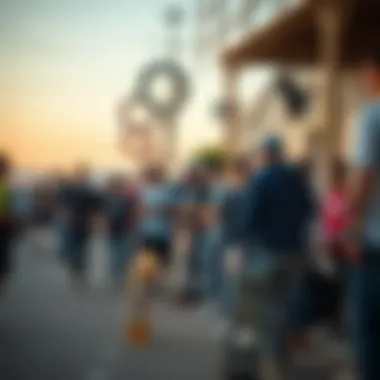

On the production line, addressing waste is a significant topic. Workshops are innovating how they cut and assemble boards to minimize off-cuts and leftover materials. This includes implementing efficient planning in the design phase and reusing scraps for smaller skateboard accessories. For example, some companies might use wood shavings to create grip tape or other skateboard-related paraphernalia.
The act of reducing waste not only lowers production costs but also contributes to a more sustainable manufacturing process. One might say it’s like hitting two birds with one stone; fewer materials going to waste means less impact on the environment, and the savings can often be funneled back into the craft. That said, it requires a caring commitment from workshop owners and workers to make it happen, as changing ingrained habits is no small feat.
The Future of Sustainable Skateboarding
Looking ahead, the fate of sustainable skateboarding rests in both innovation and community engagement. New technologies are emerging that could further aid in recycling unwanted materials and enhancing the durability of boards. Consider solar-powered workshops or carbon-neutral shipping solutions as vital steps towards an eco-friendly future in skateboarding.
More importantly, the community must engage with these changing trends. Awareness campaigns and appreciation for eco-conscious products can drive consumer demand. As skaters, the community has the power to foster change and elevate sustainable practices from mere trends to accepted norms. Moving forward, it is essential to cultivate a culture that prioritizes not just performance but also the health of our planet.
The embrace of sustainability within workshop skateboarding may change the landscape, proving that there's more than just passion at play; there's purpose.
As skateboarding continues to move closer to a sustainable future, every decision made in the workshop—whether it’s the source of the wood or how to cut the pieces—carries weight. The connection between sustainable practices and the skateboard culture is undeniable and can be the backbone for defining what the future holds.
Utilizing Technology in Skateboard Manufacturing
In the ever-evolving landscape of skateboard design and production, technology plays a pivotal role. The integration of advanced tools and processes not only enhances the crafting of skateboards but also shapes the entire industry’s future. By leveraging modern technologies, workshop skateboard manufacturers can foster innovation, improve performance, and cater to the surfers' personalized needs. Adopting these advancements isn’t just about keeping up; it’s about redefining what a skateboard can be.
Innovations in Design Software
Today, skateboard designers have access to robust design software that makes the creative process more efficient and precise. There are several powerful programs like Adobe Illustrator and AutoCAD, tailored for custom designs where artists can sketch out concepts before they take physical form. This software enables designers to rapidly test shapes, sizes, and graphics.
- User-Friendly Interfaces: Many modern platforms boast accessible interfaces. This is a boon for individuals who may not be professional designers. Passionate skateboarders can craft their unique designs, adding an element of personal touch.
- Precision and Accuracy: Sophisticated algorithms allow for measurements to be pixel-perfect, which is imperative when creating pieces that need to fit seamlessly together.
- Feedback and Iteration: With software simulations, designers get instant feedback on how changes affect board performance. This capacity to visualize results before executing a project can save both time and materials.
By utilizing such design programs, workshop owners can streamline their operations and push the boundaries of creativity.
3D Printing Impacts
3D printing is another game changer in skateboard manufacturing. It presents a revolutionary way to create prototypes and even final products.
- Rapid Prototyping: With this technology, manufacturers can quickly produce prototype skateboards or components. If a design doesn’t perform as expected, it can be tweaked and reprinted swiftly, significantly reducing development time.
- Customization at Scale: 3D printing enables the creation of customized elements, like unique trucks or wheels. Those who want their personality reflected on their board can get exactly what they’re looking for, leading to a more individualized skating experience.
- Reduced Waste: This process is highly efficient as it uses exactly what materials are needed. There’s less offcut waste compared to traditional methods which can be extremely beneficial for sustainability.
"The advent of 3D printing and advanced design software allows us to think outside the box while creating products that are both functional and artistically remarkable."
In summary, the inclusion of technology in workshop skateboard manufacturing has opened doors to unprecedented possibilities. As designs become more intricate and tailored to the rider's preferences, it is clear that the future of skateboarding might just depend on keeping pace with technological advancements. For some skate shops, this integration represents not just a trend, but rather a fundamental shift in how skateboards are conceptualized and produced.
For further reading on evolving technology in design, check out resources at Britannica and explore discussions about skateboarding trends on Reddit.
Trends in Workshop Skateboarding
The skateboard scene has always been a blend of innovation and tradition, and sketching the trends in workshop skateboarding offers a window into the evolving identity of the sport. These trends reflect a broader cultural narrative, capturing how they interact with society, technology, and even art. Understanding these elements not only helps enthusiasts keep up with current movements but enhances the way they connect with this culture on a deeper level.
Skateboards today aren't just a means for transportation but are becoming canvases for personal expression. Artists are increasingly collaborating with workshops to create decks that resonate with a story or a message. From vivid designs that draw upon street art influences to minimalist aesthetics focusing on clean lines, the styles emerging tap into a vast array of cultural currents. It’s important to note how the identity of skateboarding is inherently tied to place and community, needing to resonate locally while simultaneously appealing on a broader scale.
Emerging Styles and Influences
The landscape of skateboard design is bustling with fresh styles, influenced by a myriad of factors ranging from urban culture to technological advancements. Today’s skateboarders frequently look for customized boards, expressing their individual tastes through unique graphics and shapes that tell their story.
- Graphic Design Influences: Various styles from graphic design are merging with skateboard art. Artists like Shepard Fairey have made waves by infusing political and social statements directly into skate art, impacting how new skaters view their boards and their role in society.
- Cultural Fusion: Skateboarding blends with other cultural elements, especially in urban environments. For instance, streetwear influences from brands like Off-White and Supreme are making their way onto skateboard designs.
- Incorporation of Natural Materials: There is a noticeable movement towards using eco-friendly materials. Bamboo and recycled wood are gaining traction as alternatives to traditional maple, resonating with a crowd increasingly conscious of environmental issues.
Market Dynamics and Changes
The skateboard market is in a state of flux, driven by both external influences and internal community shifts. Small workshops are competing fiercely with larger brands, leading to changes in how skateboards are produced and marketed.
- Increase in Online Sales: As the world shifts towards digital solutions, the skateboard industry is no exception. Online retailers have gained prominence, allowing customers to find unique boards that would typically be hard to access in local stores. This accessibility helps niche brands thrive.
- Social Media's Role: Platforms like Instagram have reshaped how trends can proliferate. Skaters and brands use these channels to share new styles and ideas, instantly reaching a global audience. This has large implications, allowing for immediate feedback and trend adoption.
- Economic Variability: Economic downturns can impact discretionary spending. During challenging times, consumers might prioritize affordable skateboard options or shift back to second-hand markets, which also contribute to sustainability efforts.
"The evolution of skateboards mirrors the culture surrounding them, adapting to societal changes and responding to the voices within the community."
Understanding these market dynamics is critical for anyone involved in skateboarding, whether they are manufacturers, retailers, or skaters themselves. The trends observed today not only map out the future of skateboarding but reflect broader societal shifts as well.
For further details about skateboarding trends and culture, consider checking out Wikipedia and follow discussions on Reddit. Also, if you’re interested in the arts and tech angle, resources like Britannica can provide deeper insights into specific artists and movements.
Finale and Future Directions
As we reach the end of our exploration into the world of workshop skateboards, it's crucial to reflect on not just what has been discussed, but also on what lies ahead for this vibrant industry. Workshop skateboards are far more than just a mode of transport; they embody craftsmanship, culture, and community. The intricate details in their construction resonate with skaters, while the shared passion for skateboarding fosters connections among enthusiasts.
Reflections on the Craft
The craftsmanship behind workshop skateboards is a harmonious blend of tradition and innovation. Each board tells a story—crafted from carefully chosen wood, assembled with precision, and often adorned with artwork that speaks to the skater’s individuality. It's a labor of love. The craftsmen invest not just time, but also emotion and artistry into every piece they create. This commitment to quality ensures that each skateboard is not merely functional but also a work of art.
"In many ways, the skateboard is a canvas, and the rider is the brush. Each maneuver, each mark on the board, tells a tale that is uniquely theirs."
Skateboarders appreciate this personal touch. The connection each skater has with their board enhances the riding experience. As we look toward the future, the importance of maintaining this artisanal approach cannot be overstated. New materials and techniques continue to emerge, yet the underlying principles of craftsmanship—the heart of workshop skateboards—should always remain.
The Role of Community in Shaping Trends
The community surrounding workshop skateboards is a pulsating core of creativity and collaboration. Trends in skateboard design don’t just pop up out of thin air; they evolve from grassroots interactions. Be it at local skate parks, online forums, or during competitions, skaters influence one another. Their collective voice shapes the aesthetics and functionalities that dominate the market.
Understanding the significance of community is fundamental. Local skate shops not only serve as retail spaces but also as cultural hubs where ideas flourish. Events organized by enthusiasts embolden local legends while giving a platform to up-and-coming talent. The digital age has facilitated a bigger stage, often amplifying these trends beyond local confines.
In upcoming years, we can expect even more community-driven collaborations. The rise of sustainable practices also prompts skaters to consider how their choices affect the environment, pushing for eco-friendly brands that align with their values. As skateboard culture continues to evolve, skaters will be at the forefront, weaving new narratives while keeping the essential spirit of skateboarding alive.







